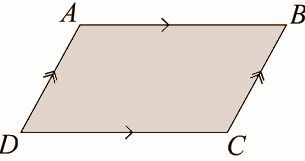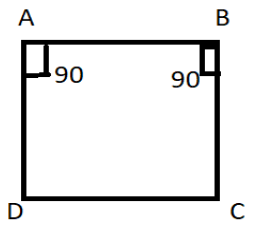
Two adjacent angles of a parallelogram have equal measure. Find the measure of each of the angles of the parallelogram.
Answer
424.9k+ views
Hint – Let ABCD be a parallelogram with $\angle A = \angle B$. Use the concept that the sum of adjacent angles is equal to 180 degrees.
Complete step-by-step solution -
Refer to the figure below of parallelogram ABCD-

We have been given in the question that adjacent angles of a parallelogram are equal.
To find: Measure of each angle of the parallelogram.
Let ABCD be a parallelogram with $\angle A = \angle B$.
Now, we know that: Sum of adjacent angles $ = {180^ \circ }$.
$\angle A + \angle B = {180^ \circ }$
Putting $\angle A = \angle B$ in the above equation, we get-
$
\angle A + \angle A = {180^ \circ } \\
\Rightarrow 2\angle A = {180^ \circ } \\
\Rightarrow \angle A = \angle B = {90^ \circ } \\
$
Now, we know the opposite angles of a parallelogram are equal.
Therefore, $\angle C = \angle A = {90^ \circ }$(Opposite angles)
And also, $\angle D = \angle B = {90^ \circ }$(Opposite angles)
Thus, each angle of the parallelogram measures ${90^ \circ }$.
Thus, the parallelogram with each angle 90 degrees is shown below-

Note – Whenever such types of question appear, assume a parallelogram and then use the conditions given in the question. As mentioned in the solution, the adjacent angles are equal, i.e., $\angle A = \angle B$, so using the concept that the sum of adjacent angles is equal to 180 degrees, find the angles A and B, and then C and D angles can be found out by the property that opposite angles of parallelogram are equal.
Complete step-by-step solution -
Refer to the figure below of parallelogram ABCD-

We have been given in the question that adjacent angles of a parallelogram are equal.
To find: Measure of each angle of the parallelogram.
Let ABCD be a parallelogram with $\angle A = \angle B$.
Now, we know that: Sum of adjacent angles $ = {180^ \circ }$.
$\angle A + \angle B = {180^ \circ }$
Putting $\angle A = \angle B$ in the above equation, we get-
$
\angle A + \angle A = {180^ \circ } \\
\Rightarrow 2\angle A = {180^ \circ } \\
\Rightarrow \angle A = \angle B = {90^ \circ } \\
$
Now, we know the opposite angles of a parallelogram are equal.
Therefore, $\angle C = \angle A = {90^ \circ }$(Opposite angles)
And also, $\angle D = \angle B = {90^ \circ }$(Opposite angles)
Thus, each angle of the parallelogram measures ${90^ \circ }$.
Thus, the parallelogram with each angle 90 degrees is shown below-

Note – Whenever such types of question appear, assume a parallelogram and then use the conditions given in the question. As mentioned in the solution, the adjacent angles are equal, i.e., $\angle A = \angle B$, so using the concept that the sum of adjacent angles is equal to 180 degrees, find the angles A and B, and then C and D angles can be found out by the property that opposite angles of parallelogram are equal.
Recently Updated Pages
The correct geometry and hybridization for XeF4 are class 11 chemistry CBSE

Water softening by Clarks process uses ACalcium bicarbonate class 11 chemistry CBSE

With reference to graphite and diamond which of the class 11 chemistry CBSE

A certain household has consumed 250 units of energy class 11 physics CBSE

The lightest metal known is A beryllium B lithium C class 11 chemistry CBSE

What is the formula mass of the iodine molecule class 11 chemistry CBSE

Trending doubts
On which river Salal project is situated A River Sutlej class 8 social science CBSE

What is the Balkan issue in brief class 8 social science CBSE

When did the NonCooperation Movement begin A August class 8 social science CBSE

Sketch larynx and explain its function in your own class 8 physics CBSE

Explain land use pattern in India and why has the land class 8 social science CBSE

In India seats are reserved for women in a Lok Sabha class 8 social science CBSE




